Nepentes: description of the plant, types and care at home
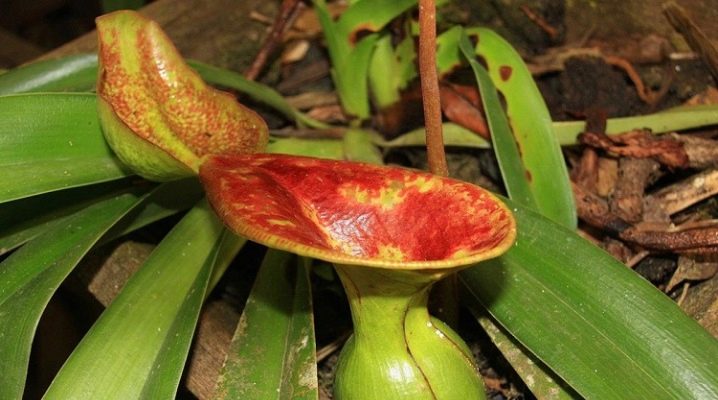
Nepentes is a spectacular plant with a predatory disposition. The huge jugs growing from its leaves have an unusual shape and look very impressive. Lovers of exotic plants appreciate the extraordinary appearance and harsh character and successfully grow it in apartments, greenhouses and conservatories. However, the plant cannot be called very popular: its breeding is a rather time-consuming process and requires certain knowledge and experience.
In addition, many types of nepentes require specific conditions, which can be quite difficult to create in urban apartments.
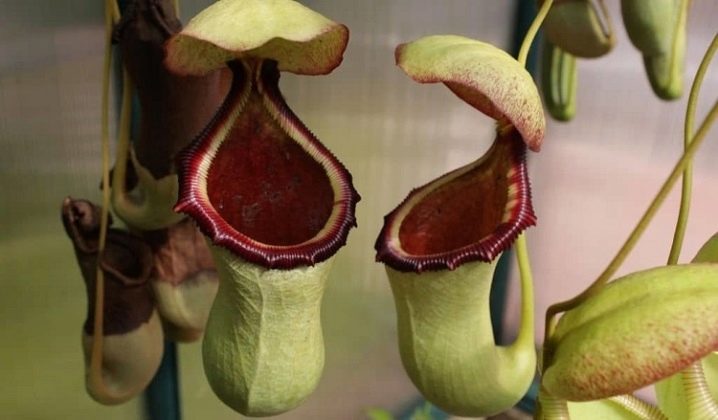
Peculiarities
Nepenthes (lat. Nepenthes), or a water lily, is a phyto-predator plant and belongs to the monotypic family of Nepenthes. Its genus has 7 officially recognized species and 247 unofficial, and the rainforests of the island of Madagascar, New Guinea and the territories of Sumatra and the Philippines are considered its homeland. Today, the species is distributed in the archipelagos of the Indian and Pacific Oceans, Sri Lanka, northern India, Malaysia and the jungles of the Australian continent. Plants like to settle in mountainous areas at an altitude of up to 2 thousand meters above sea level and prefer the edges of forests and coastal areas.
The pitcher is more often a vine, reaching a length of 20 meters in nature., however, shrub forms are also less common. Liana-shaped, twisting tree trunks, easily climb to great heights and transfer their inflorescences closer to the sun. In domestic plants, a modification of shapes and sizes is observed, which is why the average growth of indoor nepentes is 60-80 cm.
This is due to the conditions of artificial breeding, which are fundamentally different from natural ones.
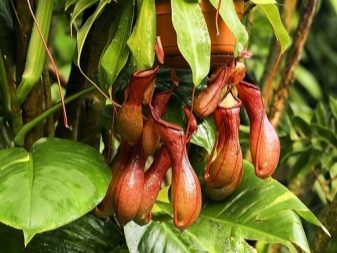
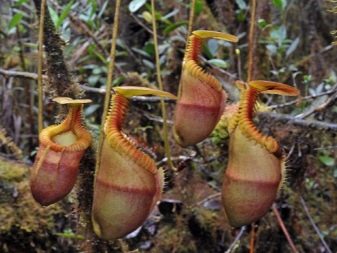
A distinctive feature of the plant is the presence of two types of leaves at once.... Some have a lanceolate classical shape, are alternately arranged along the stem and carry out the process of photosynthesis in their cells. The second - modified, are pitcher-shaped organs, covered from above with an elegant curved leaf lid. They are attached to the plant by means of long, strong tendrils, which allow them to hang freely down or twine around tree trunks.
The lid-sheet serves as a landing site for insects, does not allow the liquid inside to evaporate and protects the jug from debris and precipitation. On the inner walls of the jugs there are mouths that give off sweet and aromatic nectar. Insects quickly flock to its smell, sit on the jug and roll down. Smooth walls do not leave them not the slightest chance to catch on with antennae and suction cups, and the unidirectional bristles of the inner surface do not allow them to get out. Once inside the jug, the insect drowns in the liquid contained there and sinks to the bottom. After 8 hours, the prey is digested by means of a digestive enzyme - nepentesine, contained in the liquid, and leaves behind only a chitinous membrane.
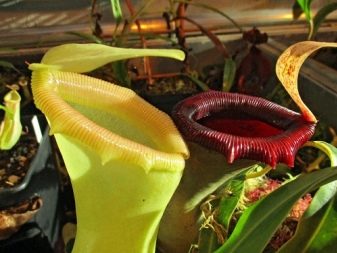
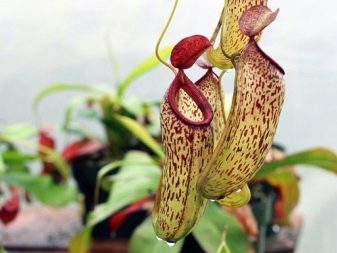
Nepentes refers to mixotrophs, that is, organisms that are able to combine autotrophic and heterotrophic nutrition. In other words, a plant is capable of absorbing water by its roots and absorbing nutrients dissolved in it from the soil, and, like a heterotroph, obtain ready-made organic matter by "eating" insects, small animals and birds.The predator flower owes this type of nutrition to the depleted lands on which it grows in its natural environment. Not receiving the required amount of nutrients from them, the plant is "forced" to feed on insects.
Erect species of nepentes, which often grow on the banks of reservoirs, hide their jugs in the grass and successfully catch in them not only mosquitoes and midges, but also toads, small birds and rodents. As for the size of the jugs, in the description of the species you can find both very small specimens 15-20 cm long, and giant half-meter jugs containing 2 liters of liquid each. Their color is also varied, especially in hybrids, among which you can see red, red-brown, light lilac and white jugs with a pattern.

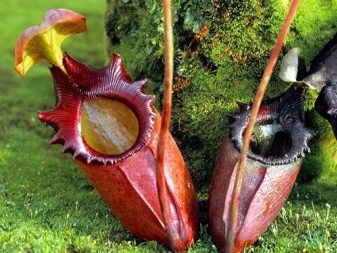
Nepentes is a dioecious plant, and outwardly it is almost impossible to distinguish male from female plants. The pitcher blooms for about six months. Its inflorescences are formed by small flowers, consist of anthers and sepals and are not particularly beautiful. The fruits are presented in the form of seed pods, behind the thin inner partitions of which there are cylindrical seeds. Nepentes is sometimes called a "hunting cup" due to the accumulation of a small amount of potable water in the jug.
It accumulates in the upper part of it, and if you act carefully, then a couple of sips can be taken completely. It is better not to get to the bottom of the jug, since there are the remains of the victims of the flower. When breeding nepentes at home, it is better to use a greenhouse or a place in a greenhouse, where it is easier to maintain the optimal temperature and humidity regime necessary for the flower.
Small species can be grown in an apartment using glass aquariums or hanging planters.
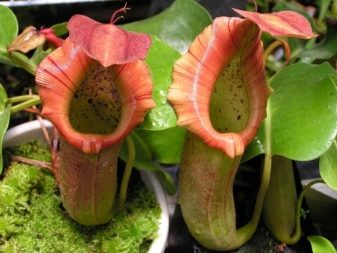
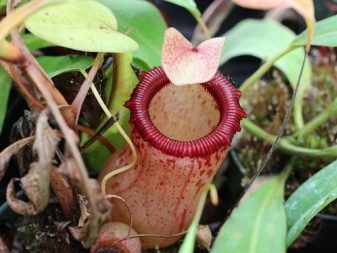
Views
The genus Nepentes includes a large number of subspecies and hybrids bred by breeders from different countries. Below is an overview of the most popular plants that are best suited for home breeding. In indoor conditions, flowers are placed in hanging pots, which allows the jugs to hang down freely. With proper care and creating favorable conditions, plants can live up to 5 years.
Larger species are suitable for greenhouse and greenhouse cultivation, where they perfectly coexist with most other plants and are not constrained in growth.
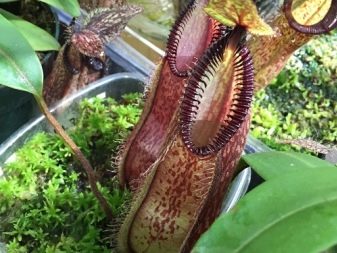
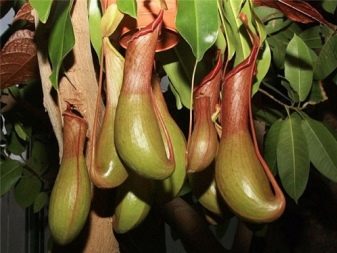
- Nepenthes rajah is an endangered species in the wild and is considered the largest of all. Its jugs reach a length of 50 cm and are distinguished by a predatory burgundy or purple color. The necks of the traps are so wide that they easily let animals and birds inside small mammals, while the giant is more favorable to mosquitoes and often releases them. For this, grateful mosquitoes, according to many biologists, help the plant to reproduce. They transfer pollen from the flower of one plant to the flower of another and thus cross-pollinate.
In an artificial environment, the plant is very demanding on external conditions and needs a lot of space.


- Nepenthes attenboroughii It is represented by a woody insectivorous plant naturally growing on the Philippine island of Palawan. The flower belongs to large species and grows up to 1.5 meters in the wild. The diameter of its lateral shoots reaches 3.5 cm, and the jugs, which can hold up to 2 liters of liquid, reach 25 cm in length. The species became known relatively recently - only in 2000, when it was accidentally discovered by Christian missionaries while conquering Victoria Peak. Seven years later, a group of biologists went there and described it. Attenborough immediately attracted the attention of naturalists and breeders around the world and rightfully took the place of perhaps the most beautiful representative of the genus: his jugs are bright light green in color and decorated with purple strokes.

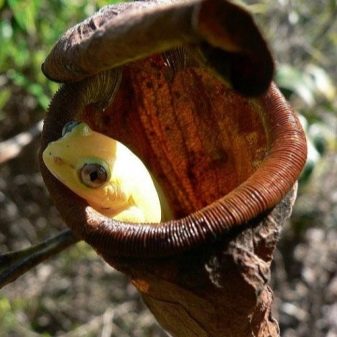
- Nepenthes Miranda is a native of tropical Asia and is presented in the form of a spectacular evergreen shrub. The jugs are shaped like laboratory flasks and look very mesmerizing. Unusual traps are given by their rich green color with bright blotches and longitudinal strokes of red.
The plant is ideal for home breeding and reaches a length of 80 cm when suspended.
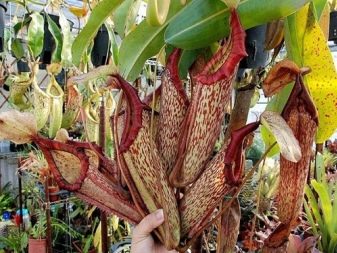
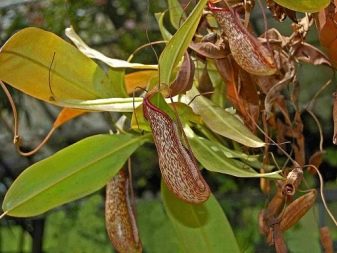
- Nepenthes Alata (winged) (lat.Nepenthes alata) in natural conditions, it reaches a length of 4 m, while in an apartment it barely grows to two. This type has high decorative characteristics and is often used by designers to decorate interiors. The jugs are painted light green, have red blotches and grow up to 25 cm.
The species is one of the most undemanding to care for and does not need high humidity.
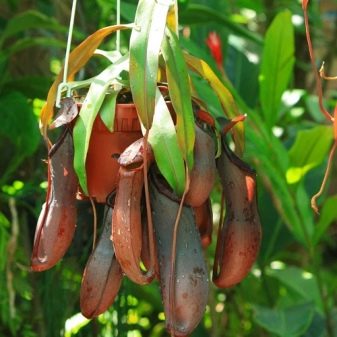
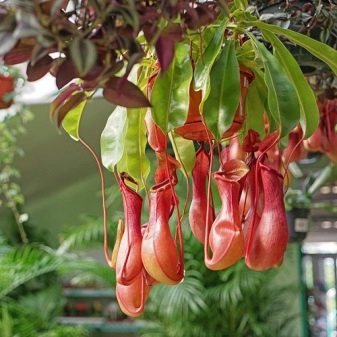
- Nepenthes Ventrata is considered one of the most hardy and adapted species for domestic breeding. The plant is a hybrid, and the alpine species Nepenthes Ventricosa and the plain Nepenthes Alata were used as parents. The flower inherited all the best qualities from them, thanks to which it is able to withstand adverse climatic conditions and form strong long-lived jugs.
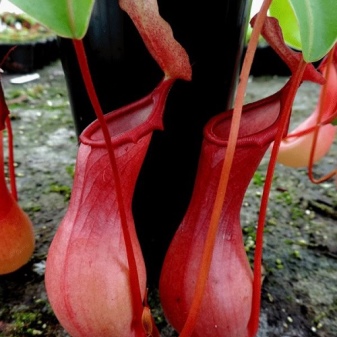
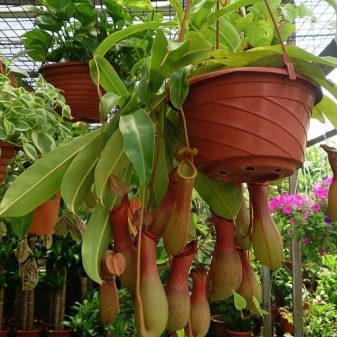
- Nepentes sanguinea, which in Latin means "blood red", is a popular domestic species, and the south of Thailand is considered its homeland. The plant grows not very large, up to 60 cm, and has dark red jugs that contrast effectively with the bright green lanceolate leaves. In some specimens, the traps have a yellowish and even slightly orange tint, which gives the flower an elegant look.
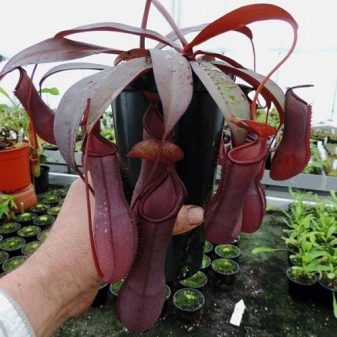

- Nepentes Hookeriana is a natural hybrid, which was initially positioned as an independent species. The plant was discovered in 1881 and owes its name to botanist Joseph Dalton Hooker, who discovered and described it. Today, the flower is often grown at home, but at the initial stage of development it is very vulnerable and requires the creation of comfortable conditions of temperature and humidity.


Conditions of detention
Most types of nepentes are quite capricious and require the creation of certain conditions of temperature, humidity and light.

Temperature and humidity
Nepentes is a thermophilic plant and does not tolerate drafts and sudden temperature changes. The creation of optimal conditions depends on the type of plant and the type of area in which it grew. So, people from mountainous areas are indifferent to daily temperature fluctuations and feel good at 20 degrees in summer, and at 16 in winter. And for species born in a forest or swampy area, the summer temperature should already be 22-25 degrees, winter - 18-20. Despite the stay of nepentes in a state of winter dormancy, lasting from October to February, the plant does not need a special drop in temperatures. For rest, it is enough for him to reduce the length of daylight hours and reduce humidity.
And if in the summer the nepentes needs 70-90% humidity, then 50 will be enough during the rest period.
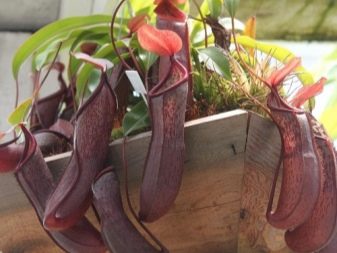
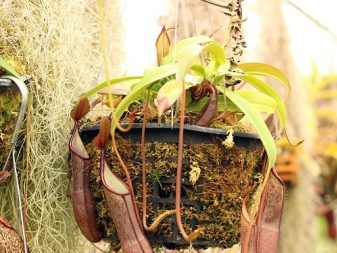
Lighting
When growing nepentes at home, it is very important to choose the right place. It is optimal to place the flower on the south or west window. If this is not possible and the apartment faces east or north, then you will need to take care of additional artificial lighting. Given the tropical origin of the genus, nepentes needs longer daylight, which should be 14-16 hours. However, despite the photophilousness, the flower should not be placed in direct sunlight.... The light for him should be bright, but at the same time diffused, which will allow the plant to saturate without harming its leaves.
To avoid burns and to create diffused lighting, you can use gauze glued to the window with tape, or net curtains.
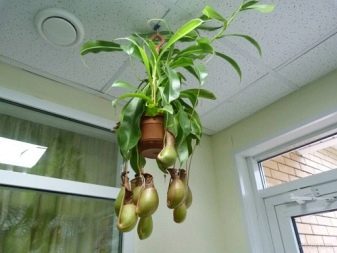
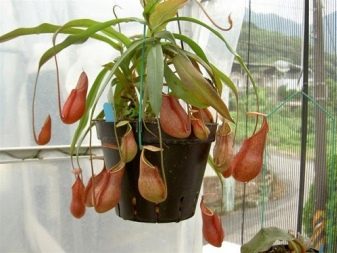
How to care?
Nepentes is quite picky about care and needs regular hydration, top dressing and timely pruning.

Watering
Like all tropical plants, nepentes loves high humidity and abundant watering. The substrate in which the flower grows must constantly be in a moist state, however, in no case should water stagnation be allowed. Water for irrigation should be warm and settled, ideally melted or rainwater. The bottom of the pot must have a perforation that allows excess liquid to drain freely. In winter, watering is slightly reduced, while preventing the complete drying out of the earth lump.
Spraying nepentes is allowed only until jugs appear on it. If this requirement is neglected, then the water that gets inside the jug will change the concentration of the digestive fluid and the plant will not be able to digest insects. As a result, they will begin to rot inside the jugs, and the flower will no longer receive organic matter. Therefore, with the appearance of the first traps, spraying a flower must be replaced with other methods of moisturizing.
To do this, you can use pallets with damp moss or pebbles, placed in the immediate vicinity of the pot.

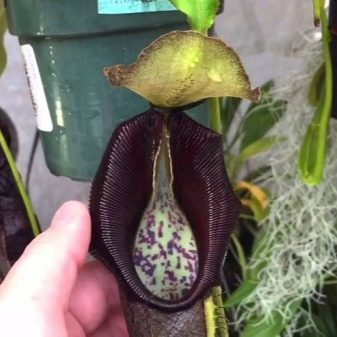
Fertilizer
Adult nepentes are fed with mineral supplements during the growing season. Fertilization is carried out twice a month, using preparations with a low nitrogen content. As foliar dressings, agents for orchids are used, reducing the dosage by 3 times from the recommended one. Only lanceolate leaves should be irrigated, trying not to get on the jugs. The frequency of spraying should not exceed twice a month.
In addition to mineral fertilizers, nepentes also needs organic supplements. To do this, the jugs themselves are fed monthly by placing a fly, mosquito or moth in them. However, it is not recommended to put feed in all containers at once. It is necessary to conditionally divide them into two halves, and feed only one part every month. When placing the top dressing inside the jug, be careful not to let any liquid spill out. If such a nuisance occurs, then you need to add a little distilled water inside, but you can no longer put an insect there. The fact is that the digestive fluid is a "non-renewable resource" and is produced only once during the formation of a jug. The refilled specimens hang for some time, but they dry up and fall off much faster than the "working" vessels.
In winter, when the plant is at rest, any feeding should be stopped.
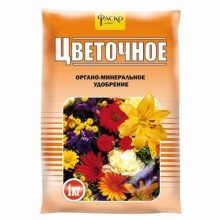
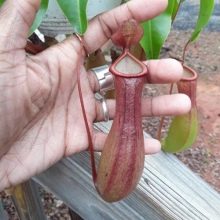
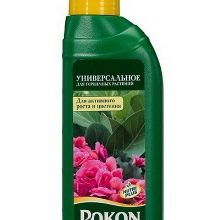
Pruning and garter
In order for the crown of nepentes to be beautiful and attractive, the plant must be regularly pinched and pruned. For the first time, the procedure is carried out after the appearance of the sixth leaf, while removing too long loops and overgrown shoots. Timely pruning saves plant vigor significantly and encourages new jugs to emerge. Liana-like species, in addition to pruning, need to create a support around which the plant will twine around and which will replace the trunk of a tree.
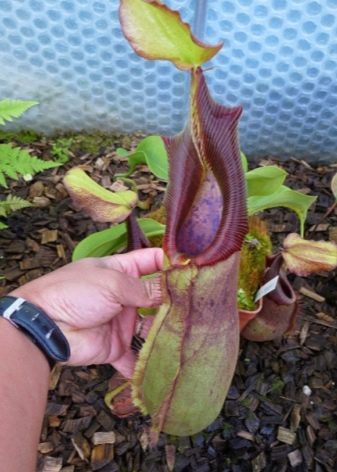

Transfer
Nepentes needs to be transplanted every 2 years, but if the plant grows quickly and does not fit in a pot, then annual transplants are allowed. The procedure is carried out in mid-spring using the transshipment method. It is important not to break the taproot during transplantation, which is quite fragile and easily injured. A new soil substrate can be purchased at the store (soil for orchids or epiphytes), or you can prepare it yourself. For this, 4 parts of sphagnum moss are mixed with three parts of coconut fiber and the same amount of chopped pine bark.
One part of peat, quartz sand and perlite is added to the resulting mixture.Then all components are mixed well, mechanical debris and organic residues are removed and sent to the oven. Disinfection is carried out for 20 minutes at a temperature of 200 degrees. When adding peat, it is important not to violate the recommended proportions, since its high content increases the acidity of the soil and has a bad effect on the condition of the flower.
A new pot is taken 3 cm wider than the previous one, a drainage layer of expanded clay or river pebbles is laid on its bottom. Then a little substrate is poured and the root system is placed there. The remaining soil mixture is poured round the root around the root, slightly compacted, and sphagnum moss is placed on top.

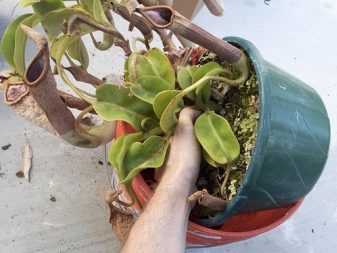
Reproduction
You can propagate nepentes by seeds, cuttings, aerial shoots and dividing the bush. The choice of method depends on what tasks the florist sets for himself and how quickly it is necessary to get offspring.
The seed method is rarely used. It requires a lot of labor, is very time-consuming and does not always lead to the desired result. For sowing, take a small container with holes in the bottom and put sphagnum moss in it, previously cleaned of debris and plant inclusions. The seeds are evenly spread over the moss surface, moistened and covered with cling film. The humidity in the greenhouse should be 90% at a temperature of 20 degrees.
A phytolamp is placed over the greenhouse and turned on for 12-14 hours daily. The film is lifted briefly every day, and distilled water is used to spray the moss. The first shoots appear within a month, and after 2-3 leaves are formed on them, they are transplanted in separate containers.
When transplanting, the roots are pried with a fork and, together with the moss, are transferred to a pot with a substrate.
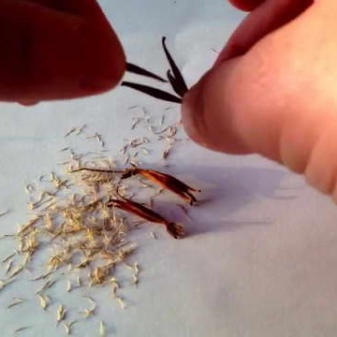
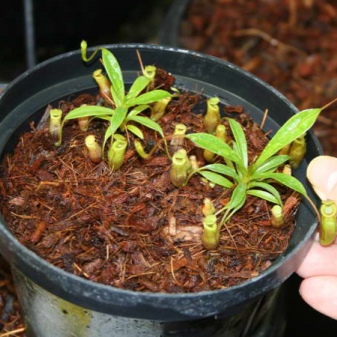
Cutting is the easiest and most effective way of propagation.... To do this, in the spring, a healthy shoot with 3 leaves is cut off from an adult plant, treated with a foundationol and planted in a nutritious substrate. A mini-greenhouse is built on top from a glass jar or a plastic bottle and the optimal temperature and humidity regime is maintained inside. The plant is ventilated daily and the substrate is sprayed as needed.
Immediately after rooting, and this usually happens 1.5 months after planting, the greenhouse is dismantled, and the plant is transferred to a general care regimen.
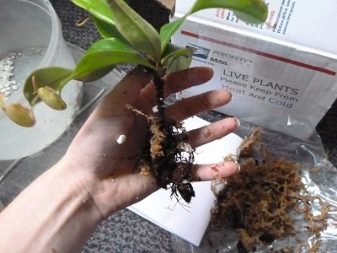
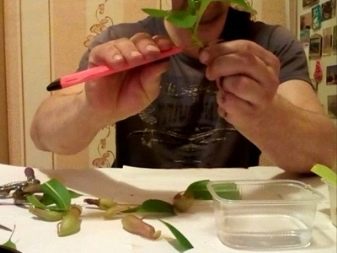
Dividing the bush perform in the process of transplanting, dividing the bush into 2 or more parts. However, this activity is very risky and can lead to the death of all shoots. Therefore, in the absence of experience and a certain amount of knowledge, it is not recommended to propagate a flower in this way.
Propagation by air layers looks like this: another container with a nutrient substrate is placed near the pot with the plant, a long vine is pressed against it and fixed with a hairpin or soft wire. The branch is regularly moistened from the sprayer, and after 2-3 weeks new roots are expected to form. After their appearance, the shoot is separated from the parent and transplanted into a separate pot.
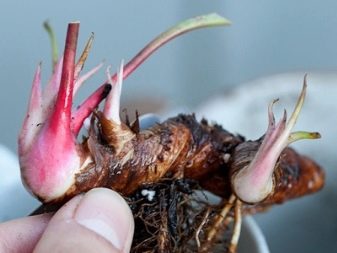
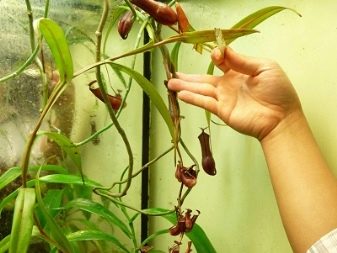
Diseases and pests
Anomalies in the development of nepentes are often associated with care errors. So, due to a lack of light, the leaves become very shallow, and from its excess they turn red and become covered with brown spots. The yellowness of the shoots and leaves indicates a lack of nutrition, and a black stem indicates rotting of the roots due to excessive moisture.
Of the pests, nepentes most often attack mealybugs and aphids, the appearance of which is often associated with excessive dryness of the air. In such cases, increasing the humidity and treating the plant with insecticides will help.
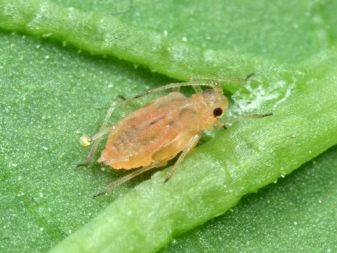

You can find out how to care for nepentes by watching the video.























The comment was sent successfully.